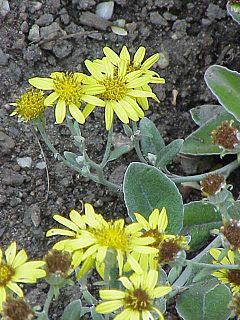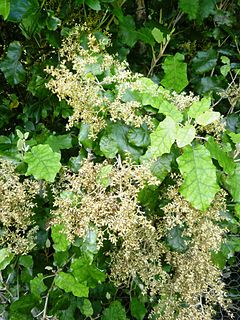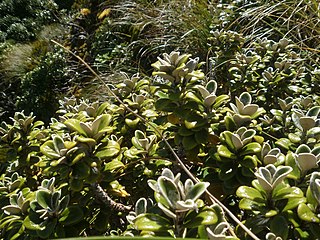The flora of the Chatham Islands consists of around 388 terrestrial plant species, of which 47 are endemic. The Chatham Islands make up the Chatham floristic province of the Neozeylandic Region of the Antarctic Kingdom.
Hebe traversii and the synonym Veronica traversii are unresolved names for an ornamental plant of the family Plantaginaceae. It is a native plant endemic to New Zealand. The specific epithet traversii is in honor of naturalist Henry H. Travers (1844-1928), son of William Thomas Locke Travers.
The Three Kings rangiora is a species of flowering plant in the family Asteraceae. It is endemic to New Zealand, where it is known only from the Three Kings Islands.

Brachyglottis is a genus of flowering plants in the aster family, Asteraceae. The genus was erected on November 29, 1775, by Johann Reinhold Forster and Georg Forster. The name was derived from the Greek brachus ("short") and glottis, a reference to the size of the ray florets.
Brachyglottis pentacopa is a species of flowering plant in the Asteraceae family. It is found only in New Zealand.
Brachyglottis perdicioides is a species of flowering plant in the Asteraceae family. It is found only in New Zealand.
Olearia traversiorum, the Chatham Island akeake, or Chatham Island tree daisy, is a species of flowering plant in the Asteraceae family. It is endemic to the Chatham Islands of New Zealand. It is also known by the synonym O. traversii.

Xylotoles costatus, the Pitt Island longhorn beetle, is a species of beetle in the family Cerambycidae. It is endemic to the Chatham Islands. Once thought to be extinct, it is now known to survive on South East Island/Rangatira; being therefore an example of a so-called "Lazarus taxon".

Brachyglottis greyi, also called Senecio greyi, with the common name daisy bush is a member of the large Asteraceae family and belongs to the genus Brachyglottis or the genus Senecio depending on which authority is being followed, an endemic native of New Zealand and lately getting positive attention from gardeners.
Henry Hammersley Travers was a New Zealand naturalist, professional collector and taxidermist. He was the son of the politician William Travers.

Archeria traversii is a species of shrub in the heath family (Ericaceae).
Stigmella cypracma is a species of moth in the family Nepticulidae. It is endemic to New Zealand.

Brachyglottis repanda is a small, bushy tree or tall shrub endemic to New Zealand. It grows to a height of 5 to 7 metres. The large leaves with a soft furry underside have been referred to as "bushman's toilet paper".
Brachyglottis stewartiae is a species of flowering plant, often referred to as a tree daisy, in the Asteraceae family. It is found only in New Zealand, especially on its subantarctic islands. With another tree daisy, Olearia lyallii, it is common in the forest of the Snares Islands, growing to about 6 m in height. It bears conspicuous clusters of yellow daisy-like flowers.

Brachyglottis monroi is a species of plant in the family Asteraceae, formerly classified in the genus Senecio. Native to New Zealand and Tasmania, it is a small, hardy, evergreen shrub growing to 1 m with crinkly-edged, olive green, leathery leaves and yellow daisy-like flowers in terminal corymbs in summer.

Brachyglottis bidwillii is a species of flowering plant in the aster family, Asteraceae. It is endemic to New Zealand.
Pimelea traversii is a species of shrub in the family Thymelaeaceae. It is native to New Zealand. The specific epithet traversii is in honor of naturalist Henry H. Travers (1844-1928), son of William Thomas Locke Travers.

Pseudowintera traversii, sometimes called Travers horopito, is a species of woody shrub in the family Winteraceae. The specific epithet traversii is in honor of naturalist Henry H. Travers (1844-1928), son of William Thomas Locke Travers.








